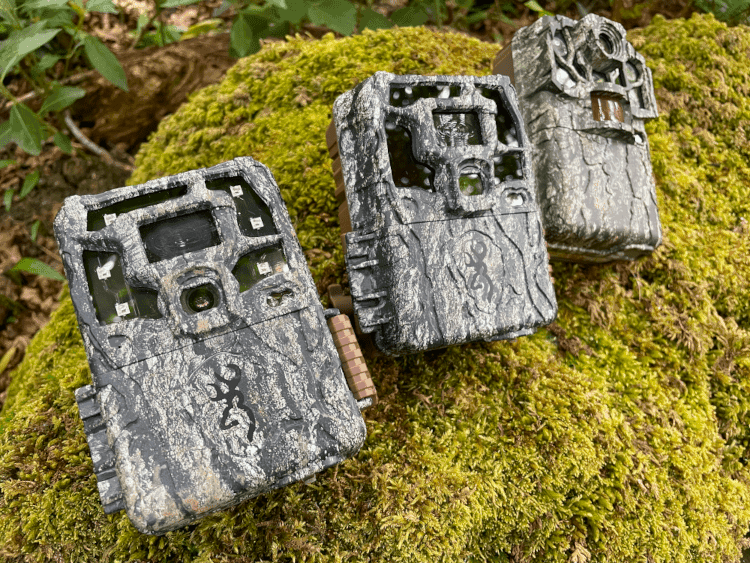Batteries & Camera Traps
Batteries are the number one cause of issues in trail cameras and the type and brand of batteries you use will determine how well it performs.
Here we’ll explain how and why battery choice is so important including our recommendations for best performance and which ones to avoid (hint… it's Duracell).

Trail Cam Issues Caused by Batteries
Many of the issues camera traps experience are due to flat, low power, or just poor-quality batteries. In fact, the majority of issues that we hear about are resolved when batteries are replaced. If you’re experiencing any of the following issues with your camera just change the batteries:
- Camera screen flashing on and off
- Shorter videos than you’ve set
- Poor detection/missing things
- Taking a picture but no video in hybrid mode (Bushnell Core, Spypoint, Ltl Acorn)
- Screen not coming on
- Not triggering at all
- Inconsistent performance
- Turning the camera on but the battery percentage or bar going down steadily, then turning off
- Dull LEDs or infrared flash brightness
Beware of Unreliable Battery Meters
One of the most common concerns people come to us with is that their camera says the batteries have 2 out of 3 bars or 90% left etc. but has stopped taking videos/photos overnight or is taking shorter videos than set - essentially it just means that it’s time to change the batteries. Unfortunately, the battery meters are not very reliable – what’s important is the load on the batteries.
What’s Load Got to Do With it?
The camera needs very little power to simply just switch on and light up the screen, so when you do this, the batteries will report that they’re happy. However, when it starts recording, especially at night, it needs much more power and the batteries are put under a much higher load and the current they give out can fall - especially if they’re not very good. That means that although there may be enough power in the batteries to trigger the camera and allow the LEDs to come on, they will struggle when it comes to actually recording. This will start a cycle of the batteries having just enough juice to trigger and start recording, but not enough power to keep the recording going.
Our #1 Recommendation: Lithium Batteries
We always recommend Lithium AA batteries, and specifically Energizer Ultimate Lithium. Here’s why:
- High voltage: The technical bit - trail cameras are either a 6V or more commonly, a 12V system. This means they run off 8 batteries all at once and need at least 1.5V from each battery. When new, Lithium’s are around 1.85V per battery compared to alkaline at 1.7V and rechargeable at 1.2V!
- Unaffected by the cold: They don’t care about cold temperatures, performing as normal down to -15C
- Longer lasting: They last about 5x longer than alkaline batteries
- Higher battery current: The other magic number to look out for is the mAh - or milliamp hours. A camera trap needs a minimum of 2500mAh to power the LEDs at night and Lithium’s have around 2900mAh – much higher than other battery types
- More cost effective: Higher voltage and current leads to far better performance and much longer battery life and thus much more cost-effective in the long-term
- Better detection: Their extra power also means better detection distances, faster speed and brighter IR LEDs

What About Alkaline Batteries?
Alkaline are of course the most common type of battery available, and whilst they absolutely do power trail cameras, they can also cause issues and have a lot of faults such as:
- Lower voltage: 1.7V compared to Lithium’s 1.85V
- Don’t work well in cold temperatures: They can only output one fifth of their power below 5C
- Unreliable current: One pack might be 1700mAh and the next 2500mAh and as mentioned trail cameras need a minimum of 2500mAh
- Not cost effective: Lasts about one fifth of the time that Lithium’s can last – despite being cheaper they are not as cost effective
- Not suited to trail cams: Cheap alkaline cameras may work great in your alarm clock or remote controls, but they are not likely to work well in a trail camera
- Our top tip: Even very well-known brands that spend a lot of money on marketing make poor batteries for wildlife cameras
Although nowhere near as good as the Lithium batteries, the Alkaline batteries we recommend are Energizer Industrial Alkaline. These have more power than most other Alkaline batteries and are very affordable.
A Word on Duracell
After ten years’ experience and lots of testing we have found the worst brand of battery to use in a trail camera is Duracell (aside from cheap Zinc batteries). This is because they have a lower capacity than other brands and are built to cling on to power rather than give it away. This isn’t a great fit for a trail cam which needs to decide when it does and doesn’t need power.
Rechargeable Batteries
This has really changed over the years. Originally, you couldn't really get away with using rechargeable batteries. Now however, you can - in specific cameras. All NatureSpy, Browning, and Camojojo cameras can run off rechargeable batteries. Ideally, we’d all just use rechargeable batteries in our wildlife cameras. There are some things to bear in mind however;
- Lower voltage: They’re only 1.2V per battery
- Milliamp hours vary: This varies a lot between different rechargeable batteries but is always printed on the packaging or batteries themselves. If they have 2500mAh as a minimum, it is likely to power a camera trap. However…
- ...Be aware of false promises: Most rechargeable batteries give numbers that in reality don’t back up with performance
- If you want to use rechargeables… The ones to look out for are Panasonic Eneloop Pro and Ikea LADDA 2450 - these, in general, will do the job if you are only interested in rechargeable batteries
- … But if you do: Be prepared to lose some performance - using rechargeable batteries can mean a loss of detection range, slower trigger speeds and reduce IR LED brightness
- They won’t last as long as you think: Finally - rechargeable batteries lose a bit of capacity every time you charge them. Eventually, they won’t have enough power to operate the camera at night, and usually need replacing after approx. 9-18 months

The Takeaways
- Use Lithium Batteries: Energizer Ultimate or Varta Professional are best - they don’t care about cold temperatures and have high currents
- Don’t use Duracell Batteries: The voltage of these is too low to power camera traps sufficiently and they don't like the cold!
- If you’re experiencing problems – change the batteries: If you are experiencing any issue with your trail camera change the batteries - your problem will probably be instantly resolved!
Please recycle your batteries if and when you can when they are no longer in use. This can be done at most recycling centres and some supermarkets.
Happy Camera Trapping!
The content of this article is copyright of NatureSpy. All rights reserved.
You may print and/or download its contents for your own personal, non-commercial use only.
Re-sale, commercial exploitation, third-party use and any redistribution or reproduction of part or all its contents in any form is prohibited without express written permission.
Nor may you transmit or store any of its contents in any other website or other form of electronic retrieval system.


